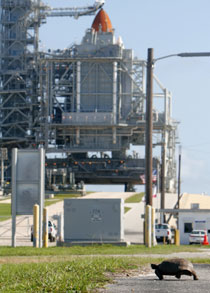NASA weighs new shuttle foam problem
(AP)
Updated: 2006-07-04 06:49
The tank expanded when the super-cold fuel was drained after Sunday's launch
was canceled because of the weather. The ice that formed "pinched" some of that
foam, causing the quarter-inch-wide crack and the piece of foam to drop off,
Shannon said.

A gopher tortoise
moves down the road to the space shuttle Discovery, seen sitting on the
launch pad at the Kennedy Space Center in Cape Canaveral, Florida, July 3,
2006. NASA inspectors found a crack in the foam insulation of space
shuttle Discovery's fuel tank and managers were meeting on Monday to
decide how the crack might affect Tuesday's launch.
[Reuters] | The size of the fallen foam was less
than half the size of one that could cause damage, NASA officials said.
"Although it is in an area that we don't like to see foam come off ... it
would not have caused damage to the orbiter itself," said John Shannon, deputy
manager of the space shuttle program.
Outside experts had mixed opinions on what NASA should do.
Osheroff said he was disturbed to hear about the small chunk of foam that
fell off while the spacecraft was at rest. His own experiments at Stanford
University show that the foam would weigh double what NASA anticipates if water
gets into it, leading to potentially catastrophic results if it hits the
shuttle.
On the other hand, another member of the Columbia accident board, John
Logsdon, director of the Space Policy Institute at George Washington University,
said NASA doesn't have "all the information, but they have no information that
says not to go."
Inspectors spotted the crack in the foam insulation during an overnight check
of the shuttle. NASA had scrubbed launch plans Saturday and Sunday because of
weather problems.
The forecast for a Tuesday liftoff was better than previous days, with just a
40 percent chance that storm clouds would prevent liftoff.
NASA Administrator Michael Griffin decided last week that the
shuttle should go into orbit as planned, despite the concerns of two top agency
managers, including the top safety officer, who wanted additional repairs to the foam
insulation.
The mission for Discovery's crew this time is to test shuttle-inspection
techniques, deliver supplies to the international space station and drop off
European Space Agency astronaut Thomas Reiter for a six-month stay.
|